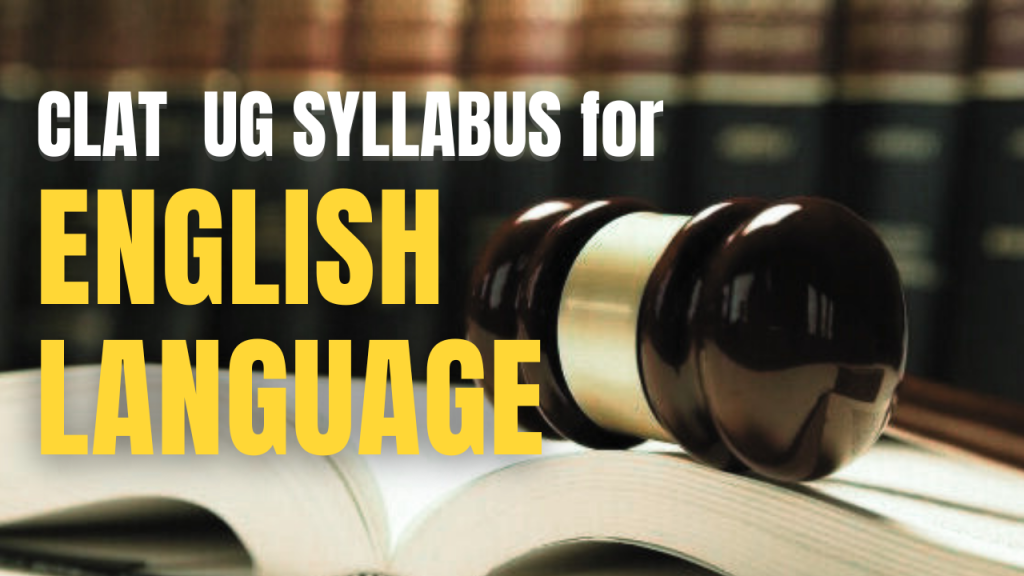In this article, we have discussed CLAT English Language, its syllabus, important topics, and preparation tips.
The Consortium of National Law University conducts the CLAT Exam for admissions in various UG and PG Law Programs in India. Common Law Entrance Test is a national-level test that serves as an entrance to 24 NLUs in India. It is also regarded as one of India’s toughest and lengthiest law exams. Hence, cracking CLAT requires one to prepare efficiently and with determined consistency. To know whether you qualify for the eligibility criteria or not, visit CLAT Eligibility Criteria.

The CLAT exam consists of 5 sections- English Language, Current Affairs & GK, Legal Reasoning, Logical Reasoning, and Quantitative Techniques. Each section requires focus and determination to ace it in the CLAT Exam.
In this article, we will guide you to the Detailed CLAT Syllabus, Pattern, and Important Topics for the English Language along with section-wise weightage and the CLAT Preparation Strategy.
CLAT English Language: An Overview (Pattern & Sectional Weightage)
The English Language is a crucial section, and doing well in this area will greatly increase your CLAT score. Acing this section is challenging and requires dedicated planning and preparation.
As per the updated CLAT Exam Pattern, the English Language section consists of passages of 450 words followed by 4-5 questions. These passages are picked from history, fiction, and non-fiction genres. It will consist of 22-26 questions contributing 20% of the total CLAT Syllabus. Check the analysis of the section along with the updated pattern and marking scheme below:
| CLAT English Language Particulars | Details |
|---|---|
| Total number of questions in English Language section | 22-26 Multiple Choice Questions |
| Sectional Weightage in CLAT | 20% |
| Total Marks in the English Language Section | 22-26 Marks |
| Number of Passages | 4-6 |
| Marking Scheme | +1 for every correct answer -0.25 for every incorrect answer |
The candidate should possess the following skills in order to ace the CLAT English Language section:
- Read and understand the arguments, and points of view presented in the passage.
- Understand the meaning and context of different terms and phrases used in the passage.
- Interpret and derive Conclusions from the passage.
Also, read the Best CLAT books for CLAT 2025.
CLAT English Language Syllabus

The English Language section in CLAT consists of various topics revolving around grammar, vocabulary and reading comprehension. Acing this section requires a good command on vocabulary and grammar. Knowing the syllabus will give you a fair idea about the topics you need to focus more on.
Below mentioned are the important topics under the CLAT English Language section:
| Important Topics | Important Topics |
|---|---|
| Reading and Comprehension | Sentence Completion |
| Error Detection | Para Jumbles/ Sentence Rearrangement |
| Idioms and Phrases | Synonyms and Antonyms |
| Fill in the Blanks | Vocabulary |
| Syntax Errors | Sentence Structure |
| Cloze Test | Foreign Language Words |
It is important to dictate yourself in improving your CLAT English language vocabulary to the best of your capability. One should focus on increasing their reading speed keeping in mind accuracy as well. You also need to develop a strong vocabulary to ace this section effectively.
Also, read the AILET Preparation Strategy 2025.
CLAT English Language Preparation Tips
Most of you preparing for CLAT may believe you don’t need to practice the English Language too much. However, this is not true. This section has to be given the same importance as other sections.
Also read: NLU Fees Structure of all the National Law Universities
The following mentioned tips will not only help you crack but ace the CLAT English Language section:
Preparation Tips for Reading Comprehension
- Pay close attention to minute details like grammar rules and implied meanings while attempting comprehension passages. The passage may not state everything and hence, you need to be very wise with every word in such passages.
- Reading the entire passage quickly is not the solution. Give yourself enough time to read each sentence, paragraph, and section to understand better.
- Practice reading comprehension passages more often. It can help you improve your ability to identify small details and read between the lines.
- Focus on Grammar Rules as they can impact your comprehension and score.
Preparation Tips for Grammar
- Go through the basic Grammar rules for CLAT English Language preparation. Do not make the mistake of picking an option that “sounds right” to you.
- Do not try to memorize grammar, instead understand the questions. The only way you can ace Grammar is by practicing a good number of questions.
- The type of grammar questions asked may vary with every paper. It is advisable to stay updated with the basics of grammar and practice them daily.
English Language Preparation Tips for Vocabulary
- Read as much as you can. Reading more gives you exposure to new words that add up to your vocabulary. With every new unfamiliar word, try searching for its meaning, synonym, and antonym to improve your vocabulary.
- Play word games. These games can help you expand your vocabulary and gain knowledge on the usage of these words.
- Try using new words you’ve learned and revise them more often in writing or conversations to strengthen their meaning and context.
- Watch English movies and TV Shows. This helps you pick up new phrases and words improving your vocab skills.
Also, Read the CLAT Legal Reasoning Preparation Tips and Strategies.
Types of Questions asked in the CLAT English Language Section
There are usually 4 to 5 Reading Comprehension passages of around 450 words in the CLAT English Language section. There will be 5 to 6 questions from each passage. All these questions would be multiple-choice questions.
CLAT UG English Language Example-
To better understand this section, we have mentioned below the types of questions that you will find in the CLAT English Language section:
Climate change is considered to be one of the most serious threats to sustainable development, with adverse impacts on the environment, human health, food security, economic activity, natural resources and physical infrastructure. According to the Intergovernmental Panel on Climate Change (IPCC), the effects of climate change have already been observed, and scientific findings indicate that precautionary and prompt action is necessary.
Vulnerability to climate change is not just a function of geography or dependence on natural resources; it also has social, economic and political dimensions that influence how climate change affects different groups. Poor people rarely have insurance to cover the loss of property due to natural calamities i.e. drought, floods, supercyclones etc. The poor communities are already struggling to cope with the existing challenges of poverty and climate variability and climate change could push many beyond their ability to cope or even survive.
It is vital that these communities are helped to adapt to the changing dynamics of nature. Adaptation is a process through which societies make themselves better able to cope with an uncertain future. Adapting to climate change entails taking the right measures to reduce the negative effects of climate change (or exploit the positive ones) by making the appropriate adjustments and changes. These range from technological options such as increased sea defences or flood-proof houses on stilts to behavioural change at the individual level, such as reducing water use in times of drought.
Other strategies include early warning systems for extreme events, better water management, improved risk management, various insurance options and biodiversity conservation. Because of the speed at which climate change is happening due to global temperature rise, it is urgent that the vulnerability of developing countries to climate change is reduced and their capacity to adapt is increased and national adaptation plans are implemented.
Communities must build their resilience, including adopting appropriate technologies while making the most of traditional knowledge and diversifying their livelihoods to cope with current and future climate stress. Local coping strategies and knowledge need to be used in synergy with government and local interventions. The need for adaptation interventions depends on national circumstances. There is a large body of knowledge and experience within local communities on coping with climatic variability and extreme weather events. Local communities have always aimed to adapt to variations in their climate.
Local coping strategies are an important element of planning for adaptation. Traditional knowledge can help to provide efficient, appropriate and time-tested ways of advising and enabling adaptation to climate change in communities that are feeling the effects of climate changes due to global warming.
[CLAT UG 2020 English Language]
Q1. To address the challenge of Climate Change, developing countries urgently require:
A. Implementation of National Adaptation
Plans
B. Adoption of short-term plans
C. Adoption of technological solutions
D. Imposition of Climate Change tax
(Correct Option: A)
Q2. Given below are the factors of vulnerability of poor people to climate change. Select the option that contains the correct answer.
(1) Their dependence on natural
resources
(2) Geographical attributes
(3) Lack of financial resources
(4) Lack of Traditional knowledge
Codes:
A. (2), (3) and (4)
B. (1), (2), (3) and (4)
C. (3) only
D. (1), (2) and (3)
(Correct Option: D)
Q3. Which of the following is against the idea portrayed in the passage?
A. Coordination between regional and National efforts is necessary.
B. The process of Adaptation to climate change does not take into account the factor of prevailing national circumstances.
C. Social dimensions of climate change also need to be appreciated.
D. Combining Traditional Knowledge with appropriate technology is the need of the hour.
(Correct Option: B)
Q4. The Traditional Knowledge should be used through
A. Improvement in national circumstances
B. Synergy between Government and local interventions
C. Imposition of Climate Change Tax.
D. Its dissemination
(Correct Option: B)
Q5. What is the meaning of the word ‘Resilience’, occurring in the passage?
A. Toughness
B. Fragility
C. Flexibility
D. Vulnerability
(Correct Option: C)
The Question given above was asked in the English Language section of CLAT 2020.
NLU Placements of all National Law Universities
Conclusion
Scoring well in the CLAT English Language section is definitely achievable if you are consistent. You need to devote an ample amount of time and follow the right preparation strategy. Here are some key points that you must keep in mind:
- While you are preparing, give equal weight to the English Language.
- Practice regularly and take timed tests and quizzes to increase your speed.
- Attempt the previous year’s questions and analyze your strengths and weaknesses.
- To improve your grammar and vocabulary, make use of high-quality study books like “Word Power Made Easy” by Norman Lewis.
- Utilize your everyday reading habits to increase your vocabulary.
- Use your time well so that you can respond to every query.
- Be prepared for the unforeseen circumstances on the test and be confident.
Top Law Entrance Exams in India
Where to Start Preparing for CLAT?
Aiming for an exam like CLAT requires you to be consistent and determined with your preparation. Get the right mentorship and 24*7 doubt-solving support from our top CLAT Mentors. Ace your CLAT with iQuanta’s CLAT Online Coaching.
Wishing you all the best in your CLAT journey!


